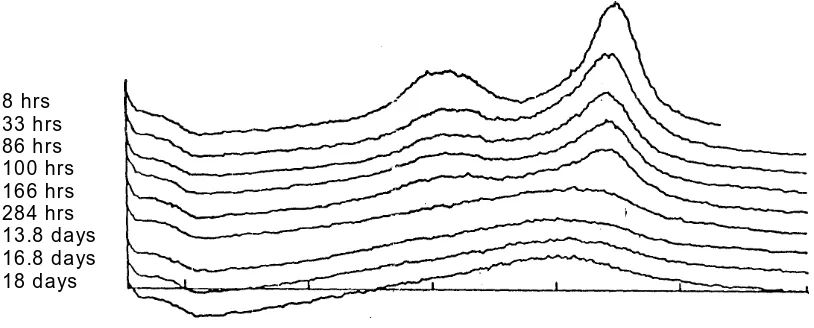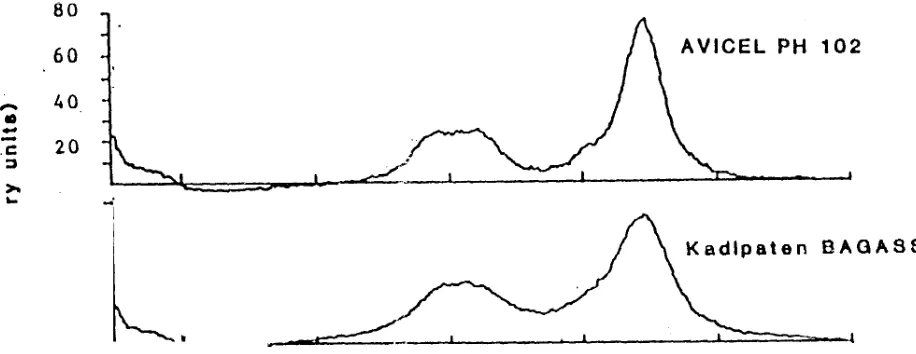Quality Control Using X-Ray Diffraction Spectroscopy on the Degree of Crystallinity of Microcrystalline Ce llulose Produced from
Sugarcane Residue.
H. Yudi Padmadisastra Faculty of Pharmacy,
Padjadjaran University, Jatinangor, Indonesia.
ABSTRACT
INTRODUCTION
The regularity and symmetry are characteristic of crystalline materials. This characteristic can be made visible by X-ray diffraction or diffractometry. If materials are irradiated by monochromatic X-ray, a pattern will be shown which is a fingerprint for the material. Microcrystalline cellulose can be analyzed in this way. One of the objectives of this study was to find out whether the
crystallinity of direc t compression exc ipient, in tablet making, made from bagasse (DICEB) with different treatments is as high as the crystallinity of AVICEL . AVICEL is one of the best direct compression excipient in the market and is a brand na me for microrysstalline cellulose.
A quantitative measure of crystallinity is very important, since it can show us the fraction of crystalline part in a specimen. Degree of crystallinity determines many of the properties of pharmaceutical solids such as flow and compaction, water uptake, dissolutio n rate, solubility, mixing and stability (Huttenrauch 1978, York 1975).
The degree of crystallinity in a solid depends on the proportion of the crystalline part in the mixture with the amorphous part. According to
Suryanayaranan a nd. Mitchell (1985) measurement of the degree
of crystallinity can be carried out by heat of solution measurements, density measurements and the most widely used powder x-ray diffraction.
In this study, powder X-ray diffraction was used. Degree of c rystallinity is estimated from the peak height of the x-ray pattern diffraction. X-ray diffraction patterns can be recorded by a scintillation counter or by a photographic film. This study used scintillation counter to measure the emitted x-ray reflected by crystals, and this reflection happens only when the Bragg equation is satisfied.
Bragg equation : n x = 2d .s in . Bragg's condition : A'B + A'C = n x
where 2d.sin. is the difference in the pathlength between two waves.
A powdered material is built from thousands of minute crystals
(crys tallites) at irregular positions . It is for this reason that Bragg equation can only be satisfied by some pa rticles in the spec imen analyzed. For a certain wavelength, the "detectable" signals are those which have inter planar spac ing bigger or same as 0 .5 . For a qualitative a nalysis of a substanc e, the
Figure 1.
Method.
X-ray measurements of degree of crystallinity are performedby recording the relative intensities of the Bragg and non-Bragg scattering. To compare two or more different crystallinities of substances prepared by different treatments, this study follows the method used by many authors i.e peak height ratio measurement of the substance in comparison with the peak height af an internal standard (Suryanayaranan & Mitchell; 1985). Lithium fluoride was used as an internal standard in his study because the location of the peaks of DICEB was not coincide with the peak of this substance.
Properties of DICEB Powder Determination of Crystallinity
Degree of crystallinity determination was carried out as follows: An X-ray diffractometer (Rigaku, Miniflex 2005, Japan) was used to determine the degree of crystallinity of AVICEL PH102 and DICEB. MCC samples were mounted in a clean, thin walled glass container similar in size to a microscope slide, which were specially made for this purpose. The glass container has a shallow rectangular hole two cm in diameter and one and a half mm depth size. Powder was pressed into the hole by using a microscope s lide. Samples were irradiated with monochromatic radia tion Cu K X-rays (30 kV-l0mA) over the scanning range of 2 from 30 to 30. Chart paper was set at fast, recorder sensitiv ity
and time constant were set at 2000 and 2 respectively. The measurements were made at room temperature. For the purp ose of investigating the effec t of grinding time on the degree of crystallinity of DICEB, the samples were made up from various ratios of crystalline part and amorphous one.
the peak height of the X-ray diffraction pattern did not decrease anymore. In this experiment DICEB was ground in a ball mill at speed level three for 18 days, this was taken to be the standard having degree of crystallinity zero percent.
To construct the standard curve of the relations hip between intensity ratio and degree of crystallinity of DICEB, 11 % of internal standard lithium
fluoride (LiF) was mixed with DICEB powder (Suryanayaranan & Mitchell, 1985). In this case DICEB powders consisted of mixtures of gradually decreasing 0 % degree of crystallinity DICEB (amorphous standard DICEB = ball milled 18 days) with increasing amounts of 100 % degree of crystallinity of DICEB (ba ll milled four hours). 9 mixtures of 0, 10, 20, 35, 50, 65, 80, 90, and 100 of degree of crystallinity were prepared Figure 2).
Results and Discussion
The ratio of X-ray diffraction intensity of DICEB at 2 = 23.4° to that of LiF (1) at 2 = 37.8° were then calculated, and a plot of intensity ratios of the two peaks height vs. degree of crystallinity was constructed (Figure 2).
Figure 2. E ffect of grinding time on crystalinity a t 8 hrs, 33 hrs., 86 hrs. , 100 hrs., 166 hrs., 284 hrs., 13.8 days, 16.8 days, 18 days, at 2 degrees
Brightness of DICEB
The brightness of the AVICEL PH102 and DICEB III was changed after heating in the oven. This was found previously also by Saeman (1945). He found that bagasse consists of three major parts i.e hemicellulose, cellulose and lignin; glucose was probably formed during wood hydrolysis from cellulose, on heating in the oven, there was probably formation of caramel from glucose.
X-Ray Diffraction Pattern of DICEB Crystallinity Index of DICEB Powder.
The advantage of X-ray powder diffraction is tha t no treatment is required and only small amount of sample is needed, and the sample is recoverable in this non-destructive method. Sinc e only limited quantities of samples were avalaible, this method was very suitable for this work. One of the objectives of this study was to find out whether the crystallinity index of DICEB was similar to the crystallinity index of AVICEL PH102, and to find out the best ball milling time to get the highest crystallinity with adequate particle s ize at the same time. Preliminary experiments showed that the x-ray diffraction patterns of DICEB prepared from bagass originated from Queensland had a peaks of silicate. However, most of the silicate and ash probably did not come from the cane but from the soil.
Figure 3 : X - ra y d iffra c tio n pa tter n o f AVIC EL P H1 02 and MCC ma d e o f Kad ipaten Bagas se
From Fig. 3 it is proofed that AVICEL PH102 and DICEB made from the raw materials from Kadipaten, qualitatively are the same. The crystallinity of DICEB appeared slightly lower than the crystallinity of AVICEL PH102 (Fig. 3).
analysis of variance, showed no statistically significant difference (p = 0.05). According to Nakai et al. (1977) wood cellulose co nsists of c rys talline and
amorphous regions. Hydrolysis occurs in the amorphous part, so that the ratio of crystalline to amorphous part is important.
Crystallinity index has been used to quantify the fractio n of crystallinity phase in a sample. Soltys (1984) suggested that crystallinity index is one of the properties of the polymer that must be included in describing it. He applied an automatic X-ray technique to measure and determine crystallinity indexes of a specimen and analysed the index.
DICEB Internal standard LiF
Figure 4. X - ray diffraction pattern of DICEB & Internal Standard (LiF) at 2 degrees.
Diffraction method has been used by Nakai et al. (1977) to determine the crystallinity of ground and unground MCC sample. They also determined the relationship between crystallinity and surface area of the ground sa mples. They found the conversion of crystals into amorphous state caused by mechanical force.
In the present work, DICEB was ground up to 18 days a nd the
decrease of the X-ray diffraction intens ities was recorded as a function of time (Fig. 2). The X-ray diffraction pattern confirmed that the increase of grinding time has a significant effect on degree of crystallinity. DICEB ground for 18 days was assumed as having 0 degree of crystallinity, since it did not decrease any more, and it was used for the construction standard curve for the
determination of the effect of grinding time on crystallinity.
Standard curve for crystallinity was constructed to determine degree of crystallinity of DICEB at various grinding times. This standard curve relates the degree of crystallinity of DICEB and intensity ratio of the X-ray diffraction peaks of DICEB at 2 = 23.4° to LiF at 37.80.
originates in the dimension of crystalline regions and the broadening were
examined by Pearse and Lewis (1972) for the copper and nickel powders. It is well known that a small crystallite size leads to line broadening.
Suryanayaranan & Mitchell (1985) suggested that decrease in crystalinity after grinding was caused by an increase in lattice disorder in the sample instead of cumulation of amorphous part in a crystalline-amorphous mixture of dehydrated calcium gluceptate. Concerning the calculation of degree of crystallinity, they also commented that when they assumed the material was 100 % crystalline, in reality it was not perfectly crystalline and it contained some defects as a result of ball milling. The same problem exist in our work with 0 % crystallinity of the 18 days ball milled DICEB: it does not mean that it is 100% amorphous and neither is the 100% crystalline material 'perfect'.
Suryanayaranan & Mitchell checked the birefringence of Ca-Glucephate after grinding to amorphous, and analyzed it under polarizing microscope. Some particles still showed birefringence. Crystalline materials usually have different density compared to amorphous one. The latter is lower because the atom location in the lattice are further away from each other. Thus bigger distances between atoms will produce decrease in volume and the density is therefore low. The low density can affect the flowability of the material.
Acknowledgements
The author wish to thank to several party, for their contribution work, ie. Dr. Igor Gonda, Senio r Lecturer at Dept. of Pharmacy, Sydney University for his tremendous help, sugges tion and patient. Keath from the Dept. of Pharmacy workshop, Sydney University, who also
contributed to the preparation of equipments during this research work. Also to Kadipaten Sugar Factory, Kadipaten Indonesia, who provide sugarcane bagasse. And last bu t not least, to Kim Chan who do the research at same laboratory.
Refferences :
1. Huttenrauch, R., and Jacob, S., 1970, Bedeutung des Prebdruck fur die Verbereitung mikrokristaliner Cellulose, Pharmazie, 25, p. 630-631.
2. Nakai et al., 1977, Effects of Grinding on Physical and Chemical Properties of Crystalline Medicinals with Microcrystalline Cellulose, I. Some Physical Properties of Crystalline Medicinals in Ground Mixture, Chem Pharm. Bull., 25, p.3340-3346.
3. Paturau, J.M., 1982, By Product of Sugar Cane Industry, 2nd edition, Sugar
4. Pearce and Lewis, 1972, X-Ray Diffraction Line Broadening Studies of Raney Copper and Nickel, J. Catalysis, 26, p. 318-325
5. Saeman, J.F.,1945, Ind. Eng., 37, 45-52 .
6. Suryanayaranan & Mitchell; 1985, Evaluation of Two concepts of
Crystallinity using Ca Glucephate as a Model Compounds, Int. J. Pharm., 24, p. 1-17.



